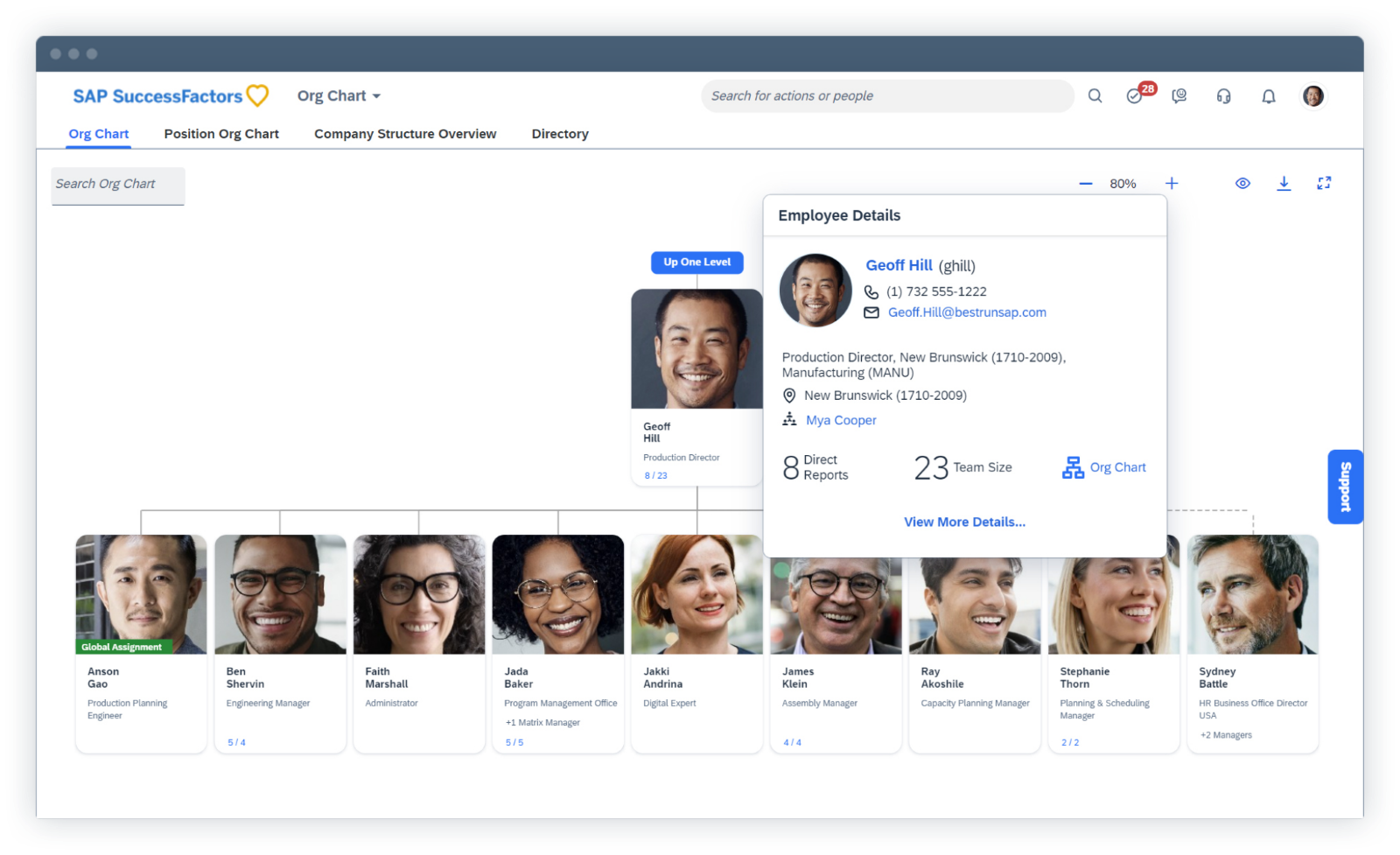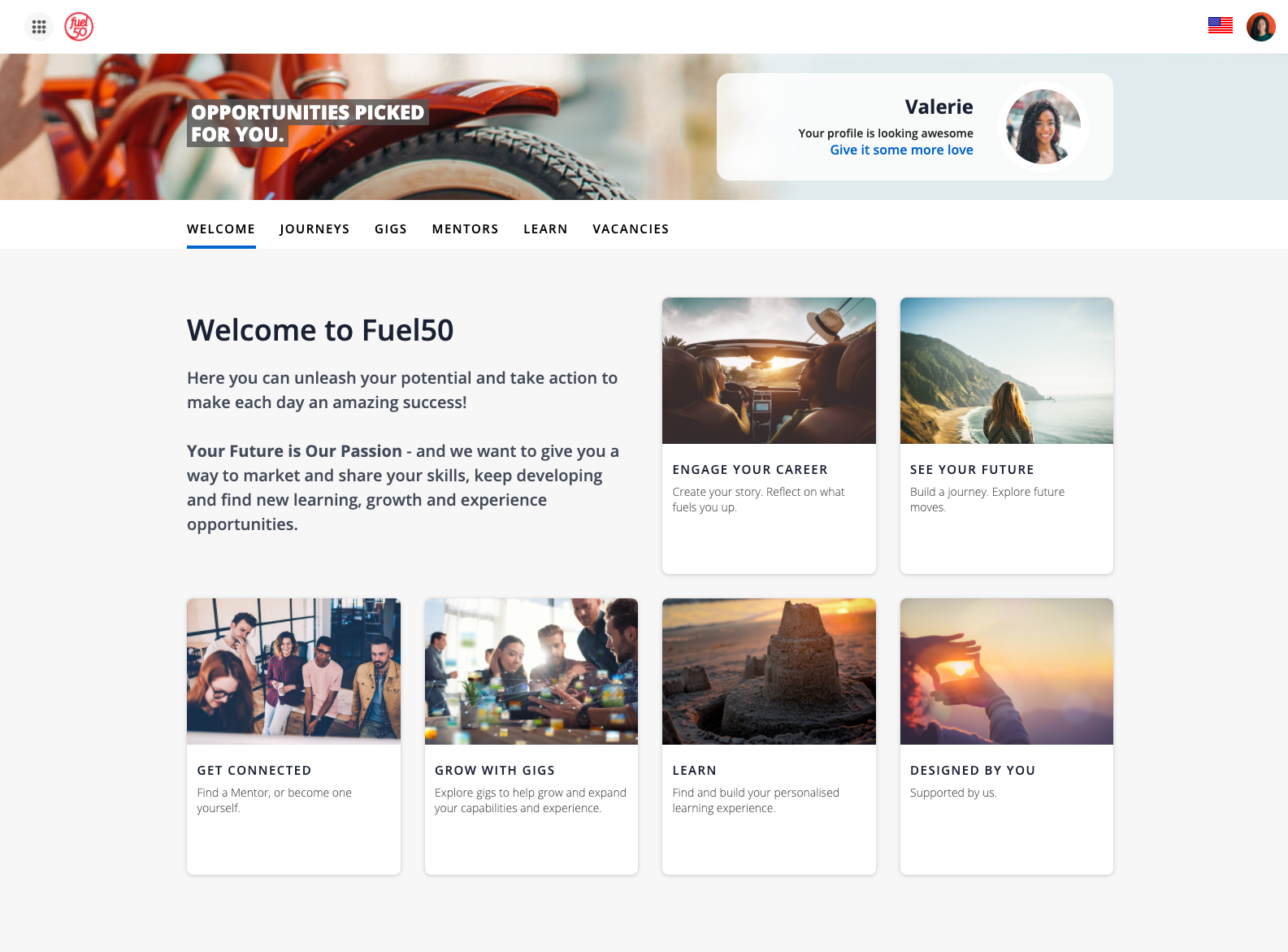SAP Human Capital Management (HCM) is a comprehensive suite of HR solutions designed to manage the entire employee lifecycle.
Originally developed as part of SAP’s Enterprise Resource Planning (ERP) system, SAP HCM has evolved to include cloud-based offerings through SAP SuccessFactors.
As a leader in the human resource management system (HRMS) software market, SAP provides innovative solutions to address critical workforce transformation needs in today’s rapidly changing business environment.
Note: Looking for a HCM centered around talent management, employee engagement and retention? Fuel50’s suite of capabilities will give you visibility on your workforce’s skills and help you maximize on internal talent. Book a demo now.
SAP Human Capital Management Overview
SAP HCM offers a range of modules and functionalities to address various aspects of human resource management.

Key features and modules of SAP HR include:
- Core HR and payroll: Manages global workforce and HR data, payroll processing, and benefits administration.
- Talent management: Includes recruiting, onboarding, learning, performance management, and succession planning.
- Time and attendance management: Tracks employee time, absences, and leave management.
- HR analytics and reporting: Provides insights into workforce data for informed decision-making.
- Employees experience management: Offers tools for employee experience management, employee engagement and feedback collection.
SAP HCM’s core functionalities focus on streamlining HR processes, ensuring compliance, and providing a unified platform for workforce management across the organization.
Advantages of SAP Human Capital Management
SAP HCM offers a range of benefits that make it a strong contender in the human resources software market.
One of the standout features of the SAP HCM modules is its ability to offer a truly integrated solution that covers all aspects of HR management. This integration allows for seamless data flow between different modules, reducing manual work and improving overall efficiency.
Additionally, SAP’s commitment to global compliance sets it apart, with localization frameworks for over 100 countries, ensuring that organizations can manage their workforce effectively across different regions.
SAP HCM’s scalability is another significant advantage, making it suitable for businesses of all sizes. Whether an organization is a small startup or a large multinational corporation, SAP HCM can adapt to meet their needs. This flexibility extends to deployment options, with both on-premises and cloud-based solutions available through SAP SuccessFactors.
Furthermore, SAP’s investment in advanced analytics and reporting capabilities provides organizations with valuable insights into their workforce. These tools enable HR professionals and business leaders to make data-driven decisions, identify trends, and proactively address potential issues.
Lastly, SAP’s commitment to continuous innovation ensures that its HCM solutions remain at the forefront of HR technology. By incorporating emerging technologies like AI and machine learning, SAP HCM helps organizations stay ahead in an ever-evolving business landscape.
Key advantages include:
-
Comprehensive, integrated HR solution
-
Global compliance and localization
-
Scalability and flexibility for businesses of all sizes
-
Advanced analytics and reporting capabilities
-
Continuous innovation and incorporation of emerging technologies
Disadvantages of SAP HCM
While SAP HCM offers numerous benefits, it also has some limitations that potential users should consider.
The system’s complexity is often cited as a significant drawback, particularly for smaller organizations or those with limited IT resources. Implementing and maintaining SAP HCM can be a challenging and resource-intensive process, often requiring specialized expertise.
Cost is another factor that may deter some organizations. The initial investment for SAP HCM, especially for on-premise solutions, can be substantial. This includes not only the software licensing fees but also the costs associated with implementation, customization, and ongoing maintenance. For smaller businesses or those with tight budgets, this high total cost of ownership may be prohibitive.
Users also report that the traditional SAP HCM interface can be less intuitive compared to more modern, cloud-native solutions. While SAP has made strides in improving user experience, particularly with its SuccessFactors offerings, some modules may still have a steeper learning curve for end-users.
Another consideration is the potential for over-customization. While SAP HCM’s flexibility allows for extensive customization to meet specific business needs, this can lead to complications during upgrades and may increase long-term maintenance costs.
Lastly, organizations considering SAP HCM should be aware of the ongoing shift towards cloud-based solutions. While SAP continues to support on-premise HCM, the company’s focus on cloud innovations through SuccessFactors may mean slower development of new features for the traditional on-premise version.
Key disadvantages include:
-
Complex implementation and maintenance
-
High total cost of ownership
-
Potentially less intuitive user interface in some modules
-
Risk of over-customization leading to upgrade difficulties
-
Slower innovation for on-premise solutions compared to cloud offerings
Note: Looking for a HCM centered around talent management, employee engagement and retention? Fuel50’s suite of capabilities will give you visibility on your workforce’s skills and help you maximize on internal talent. Book a demo now.
Alternatives to SAP Human Capital Management
Traditional alternatives
While SAP human resources management is a well-established player in the market, several other long-standing competitors offer robust HCM solutions.
These traditional alternatives have been in the market for many years and have built comprehensive suites of HR functionalities. They typically offer deep integration capabilities, extensive customization options, and have large customer bases across various industries.
These solutions are often favored by large enterprises due to their scalability and ability to handle complex organizational structures.
Let’s examine some of the key traditional alternatives to SAP HR software:
Oracle HCM Cloud
Oracle HCM Cloud is a comprehensive suite of HR applications designed to help organizations manage their entire employee lifecycle. It offers a modern, cloud-based approach to human capital management.
Key features include:
-
Unified HR processes across the enterprise
-
AI-driven insights and recommendations
-
Personalized employee experiences through Oracle ME
-
Strong analytics and reporting capabilities
-
Global HR and payroll solutions
Workday HCM
Workday Human Capital Management is a cloud-based platform that combines HR, talent management, payroll, and time tracking into a single system. It’s known for its user-friendly interface and focus on delivering personalized experiences.
Key features include:
-
Skills Cloud for AI-driven skills intelligence
-
Comprehensive workforce planning tools
-
Advanced analytics and reporting
-
Mobile-first design for on-the-go access
-
Continuous performance management
ADP Workforce Now
ADP Workforce Now is a comprehensive HR suite designed for mid-sized businesses. It offers an integrated approach to managing the entire employee lifecycle, from recruitment to retirement.
Key features include:
-
Payroll and tax filing services
-
Time and attendance tracking
-
Talent management tools
-
Benefits administration
-
HR compliance and reporting
Modern alternatives
In recent years, a new generation of HCM solutions has emerged, offering cloud-native architectures, enhanced user experiences, and advanced technologies like AI and machine learning.
These modern alternatives focus more on employee engagement, data-driven insights, and flexible, mobile-first approaches.
They often provide more agile and user-friendly interfaces compared to traditional systems, along with improved capabilities for talent management, analytics, and personalized employee experiences.
UKG (Ultimate Kronos Group)
UKG offers a comprehensive HCM suite that combines HR, payroll, talent, and workforce management into a unified platform. It’s known for its user-friendly interface and focus on employee experience.
Key features include:
-
AI-powered workforce management tools
-
Personalized employee experiences
-
Advanced analytics and reporting
-
Mobile-first design for flexibility
-
Robust compliance management
Ceridian Dayforce
Dayforce is a cloud-based HCM platform that provides a single application for HR, payroll, benefits, workforce management, and talent management. It’s particularly noted for its real-time processing capabilities.
Key features include:
-
Continuous real-time calculations
-
Integrated payroll and benefits management
-
Advanced scheduling and time tracking
-
Talent acquisition and development tools
-
Extensive compliance features
Fuel50
Fuel50 offers a talent marketplace platform focused on career pathing, skills development, and internal mobility. While not a full HCM suite, it offers modern solutions for talent management and employee engagement.

Key features include:
-
AI-driven career pathing and development
-
Skills-based talent matching
-
Internal gig marketplace
-
Personalized learning recommendations
-
Advanced analytics for workforce planning
Key Takeaways
-
SAP HCM offers a comprehensive suite of HR tools, but its complexity and high costs may be challenging for smaller organizations.
-
Traditional alternatives like Oracle HCM Cloud, Workday HCM, and ADP Workforce Now provide robust features and integration with broader HR systems, catering to a wide range of business sizes.
-
Modern alternatives such as UKG, Ceridian Dayforce, and Fuel50 focus on cloud-native architectures, enhanced employee experiences, and AI-driven insights.
-
UKG stands out for its unified approach to HR, payroll, and workforce management, while Ceridian Dayforce is known for its real-time processing capabilities.
-
Fuel50, though not a full HCM suite, offers innovative solutions for talent management and internal mobility.
Note: Looking for a HCM centered around talent management, employee engagement and retention? Fuel50’s suite of capabilities will give you visibility on your workforce’s skills and help you maximize on internal talent. Book a demo now.




